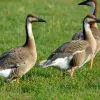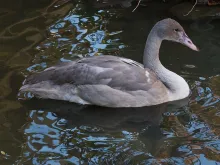
Trumpeter Swan (Cygnus buccinator)
Species name
- Dutch name:
- Trompetzwaan
- English name:
- Trumpeter Swan
- German name:
- Trompeterschwan
- French name:
- Cygne trompette
- Scientific name:
- Cygnus buccinator
Scientific classification
- Order:
- Anseriformes
- Family:
- Anatidae
- Onderfamilie:
- Anserinae
- Genus:
- Cygnus
Description
- Description:
Male:
The plumage of adult trumpeter swans is completely white, though their heads and necks are often stained a rusty color from contact with ferrous minerals in the soils of wetland bottoms during feeding. The bill has a red color on the lower madible, legs and feet are typically black But there are 1 in 7 Trumpeters have Leucism in their feet where they lose their black pigment and their feet are either blotched yellowish orange and black or pure orangeish yellow.And the iris is brown.Female:
Identical in appearance, but males typically are larger.Juveniles:
Are Greyish white to light grey tell second winter
- Behaviour:
Swans are generally aggressive and territorial, particularly while breeding, and each pair should be maintained in a separate pen, away from other swans, geese and large ducks, although the pen may be shared with small ducks, as these are usually ignored by most swan pairs. Fences adjoining other pens should be solid or screened with vegetation to avoid injury from swans trying to fight each other through wire fencing, and should be as tall as the swans themselves, to prevent fighting over the top of the fence.
Good amounts of vegetation should be provided for nest building, with cover available for early-nesting species. Parent hatching and rearing is usual. Swans are able to defend their young against most predators, and their highly-aquatic lifestyle also makes cygnets less vulnerable.
Standard Measurements
- Body Length (cm):
- The male (drake) of the Trumpeter Swan measures approximately 150-180 centimeters. The female measures approximately 150-180 centimeters.
- Body Weight (grams):
- The male will weight about 9100-12500 gram. The female will weight about 7300-10200 gram.
The weight is notoriously variable and can only be used as indication!
- Habitat:
Swans may be best kept on a large area of natural water containing aquatic vegetation, and the surrounding land. For a single pair, a pen of at least 400 square metres is suggested, of which half the area should be water and half grazing land. Banks should be at a shallow angle to allow easy entry to and exit from the water; this is particularly important if cygnets are to be parent reared. More than one pair may be kept in very large parks where each pair can establish a breeding territory. Swans appreciate water weed and grass, but other green foods such as lettuce and cabbage may be used as substitutes if necessary. They are relatively slow eaters and care should be taken in mixed enclosures that they get sufficient food. Natural food should be supplemented with floating pellets.
- Note:
Trumpeter swans are hardy and their management simple but they should be provided with a large area. They are aggressive to other birds, particularly to other swans and to geese, and can be aggressive to humans, particularly while breeding; however they usually leave smaller ducks alone. They are best maintained in their own enclosure. They may be fed floating pellets, plenty of green food and grass.
These swans breed fairly readily, laying eggs from late April to end of June, on a large pile of vegetation.
Hybridization has been reported with Whooper swan (Cygnus cygnus).
If hand-reared, cygnets should be kept in a brooder with a heat lamp (to give 33,5°C in the first week), with sufficient room for the birds to choose their own comfort zone. Access to water for a swim is appreciated; this may be in an appropriately sized bowl initially (e.g. while the brooder is cleaned out). Starter pellets, chopped green food and for the first few days chopped hard-boiled egg may be given, and grit should be available. If weather permits the cygnets may be kept outside in a pen with a pond by two to three weeks old. It is important to ensure unlimited green food is always available and that the cygnets do start feeding initially, as there is a risk of Starveout.
- Breeding:
- The female Trumpeter Swan usually lays from 4-8 dull white eggs and incubates them for 33-37 days.
- Artificial incubating:
The ideal relative humidity for incubating most waterfowl eggs is 55% (ground nesters) and 40% (cavity nesters). The temperature is usually 37.4°C. Set ventilation as recommended by the incubator manufacturer. Eggs must be turned, either automatically or by hand, a minimum of 4 times a day. As the duckling develops there is a loss of water from the egg and the air sac gets bigger. In normal development of an egg with a 33-37 days incubation, the air sac occupies about a third of it three days earlier. Cleanliness is vital and ideally eggs should be moved to a separate hatcher at this point, where the humidity should be increased to 65% and even higher once they have pipped internally.
- Bird banding:
- Recommended closed leg band ring size for the Trumpeter Swan is 27 mm.The leg band ring can only be applied on a young large swan at around 18 days old.
- It doesn't matter what leg that you band, but it's good to have a consistent system. Suggested: Left leg = Female, Right leg = Male
- Maintenance food:
-





Lundi Regular with a protein content of 20%, valuable Spirulina and high-quality by-products is optimally balanced in its composition maintenance food for water ornamental fowl of all kinds. Especially green teal and Whistling ducks that are not dependent on a very high protein content, are well supplied.
Lundi Regular contains all the minerals and vitamins in full form that are important for the animals. Therefore also suitable as breeding food.


